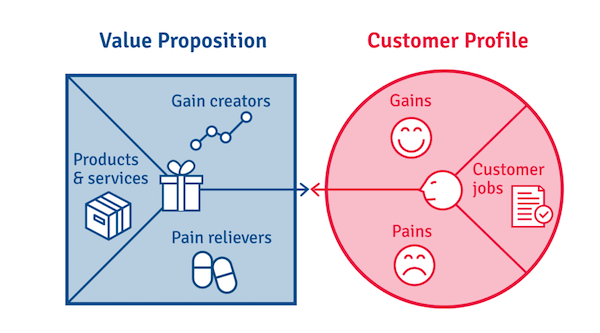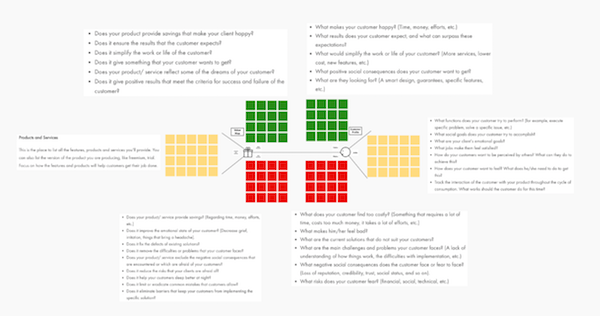Quick Summary
Understanding your core customer’s needs and aligning your offerings accordingly can significantly enhance your business competitive advantage.
Takeaways
- A Value Proposition Canvas helps align your business offerings with customer needs for a competitive edge.
- Clear understanding of your target market leads to better product-market fit.
- The canvas highlights gaps in value delivery, allowing businesses to refine their offerings.
- Regularly updating your value proposition ensures ongoing relevance and business growth.
Simple question. Why do people buy your products or services? And not your competitors’? Do you have an immediate answer? Is it short and sweet?
So often when we ask this question of our CEO clients, the answer is long and waffly. We’ll sit down with them at the start of our relationship and it’s pretty evident they have no real handle on customer motivations. In fact, they’re not even clear who their core customer is. Let alone why they want to buy the company’s products.
You have to get this clear in your head. Positioning your business for the right customers should be central to any long term strategy. It’s the only way you’re going to achieve stratospheric growth. After all, no one goes to the third-best ‘Thai/Indian fusion’ restaurant around the corner. Not when there’s a top-notch eatery specialising in Indian food in town.
Similarly, customers don’t buy drills to make holes. They buy drills to put up shelves to store books. This understanding is crucial. You want to solve a problem well for one type of customer. In fact, Black and Decker drills are often bought by wives and girlfriends and NOT male DIY enthusiasts. So be clear on the customer as they may not be the user. Engineer your business around this and you’ll cut through the noise, becoming world-famous for that one thing. Don’t just take our word for it. One of our distribution clients, Ontruck, has started growing by 20% a week since we coached them through the Value Proposition Canvas. Get this right and it’s a game-changer.
What is the ‘Value Proposition Canvas’?

This tool was designed by Alex Osterwalder as a framework to ensure that a product or service is positioned around what the customer values and needs. It’s part of his wider ‘Business Model Canvas’ which has acted as the user interface of the Lean Startup movement. When describing its power, the founder of the movement, Steve Blank, commented that instead of wasting time and effort writing a 16-page business plan, these tools force CEOs to get immediate clarity over the way forward.
The Value Proposition Canvas focuses on two distinct areas – customer profile and the company’s value proposition. If you’ve yet to achieve product-market fit, it can tell you the things you might need to change about your existing product or the nature of new products that might need to be added to your offering. If your organisation’s a startup, you don’t want to pour gasoline on the fire until you’ve achieved product-market fit. You also need to know that the market’s large enough for you to reach your goals.
Customer profile

Don’t use this tool until you have a good understanding of the identity of your core customer. And please don’t tell me you have many core customers! To achieve growth, you need to narrow this down into one core customer who will buy from you at maximum profit.
Start by laying out the customer’s jobs on the right-hand side of the canvas. Going back to the experience of our client Ontruck. We’d worked through the attribution framework and they were pretty sure they weren’t facing a business positioning issue. Instead, it was more of a ‘were they solving the right problem for their customers’ kind of thing. The fundamentals of their business didn’t need to change but the service they were offering did.
They got really detailed about their core customer’s jobs – the functional, emotional and social tasks they were trying to perform. They knew these people were responsible for shipping in medium-sized businesses. And that they needed to look clever and innovative to their boss. Their core customer didn’t want to let his or her company down with poor delivery times. Ontruck explored not just the physical jobs of their customers but also the emotional and psychological structure of doing the work.
Then they moved on to the gains and pains part of the profile. So what would be the gain for their core customer if Ontruck did these jobs easily and smoothly? Maybe they’d look good to their boss, saving money and time. Or they’d feel happy that they’d kept a promise to their own customer. Similarly, if things went badly, what were the pains their customer would be facing? Perhaps they’d look like an idiot or they’d lose control of their budget.
Customer knowledge
Often, we find clients don’t have this detail on the emotional state of their customers. That’s because the executive team is too remote from them. They aren’t speaking to enough customers on a day to day basis. This needs to change – insist that every member of your top team speaks to at least one customer every week. Make this non-negotiable. It should be diarised and set in stone.
Tap into the people in your business who do know this stuff. The ones working on the front line who are talking to customers day in, day out. You can workshop internally and pull out valuable nuggets of information. Maybe read Robert Bloom’s book ‘The Inside Advantage’ – it’s full of revealing anecdotes and describes how to gain a profound insight into your customers. Some of our clients have used Guy Washer from Opinionography to help them with this customer insight work. We’ve used him to help us with our rebranding. He’ll run workshops, pull out the information he needs and then contact your customers directly to validate its truth.
Defining your value proposition
Once you’ve completed the customer profile piece, it’s time to look at what you’re offering. List all your products and services and the way you currently describe them. Work out what elements, features or benefits lead to gain creation for your customers. And similarly, what elements will relieve the pains that you’ve identified.
These are by far the most powerful elements. Pain relievers will have four or five times more impact than those that lead to gains. Just like people are more likely to take an aspirin for a headache than a vitamin to improve their health, customers are more likely to buy something that solves a painful problem than something that’s a nice improvement.
Ontruck identified their customers’ pain as not knowing information when there was a problem with delivery. And they relieved this with their live tracking app that enabled customers to know where their stuff was, all the time. In the past, they had described their service as providing ‘24/7 proactive support’. To them, this meant they could let a customer know the delivery was going to be late before they’d realised. But did their customers know this from the way it was worded? Not really. When they looked at what they were offering through the customer lens, they realised there was a big comprehension gap.
It’s important to ensure your customers aren’t having to figure out what you’re offering. Your proposition should be immediately clear and unambiguous. No unnecessary brain cycles needed. Make sure your company website includes images of people who look like your core customer trying to do the jobs you’ve identified. The language should be their language, written through their lens.
Ontruck have changed the way they were taking their value proposition to market. Their CEO spent a couple of days a week with his sales team until they’d properly landed it. Time and effort went into finding the right form of words that could be easily understood by their core customer.
Sparking innovation
Getting clear on the gains and pains your product needs to address can spark innovation. Take the experience of Pete Newell, the internationally renowned innovation expert, who I interviewed back in January for our Melting Pot podcast. He finished his 32-year military career with a 3-year tour running the US Army’s skunkworks – or in layman’s terms, he was the Director of the US Army’s Rapid Equipping Force (REF). The problems he was trying to solve were caused by the fact that the military and civilian manufacturers didn’t speak the same language. So he had to find a way to use commercial technology to solve battlefield problems.
One of his stories involved putting armoured, remote-controlled bobcats equipped with mine sweepers into the rugged terrain of Afghanistan within six months. This activity saved thousands of lives. The army’s procurement system would have been unable to do this. It needed someone to ask the questions, ‘What’s my customer trying to do?’ Answer: go up mountain paths without the protection of armoured cars or tanks. ‘What’s the pain we’re trying to solve?’ Answer: avoiding getting arms and legs blown off by mines. ‘OK, so what product or service exists in the world that we could put together and ship to Afghanistan without a 10-year procurement process?’ Final answer: bobcats.
Pete was so successful in this role that he left the military, joined forces with Steve Blank and innovated a new academic course called ‘Hack Defence’. They open-sourced this, leading to 45 universities around the world teaching a masters degree in the interpretation of customer/military problems and civilian solutions. That’s the value proposition canvas in action, right there. Many startups have spun out of this as students on the course leave their university and form a business from what they’ve learned.
Product development
Remember, pain relief is a more powerful motivation for buying a product or service. Understanding a customer’s pain can lead to changes in products. Once you understand your core customer’s jobs and any inherent pains they’re facing, you might notice that you don’t offer anything to fix certain aspects. So you may need to adapt or build on your products.
The same drivers can lead to M&A activity. But be careful here. Companies often make the mistake of thinking, we sell x to this company so we should also sell y. They haven’t worked out that x and y are bought by completely different customers. Maybe x is sold into sales and y into marketing. Just because you have a relationship with sales, it doesn’t mean you can sell to marketing. Their jobs, gains and pains will be totally different. Make sure you have only one core customer that you serve better, and more profitably than any other competitor.
Written by business coach and leadership coaching expert Dominic Monkhouse. You can order your free copy of his book, Mind Your F**king Business here.

